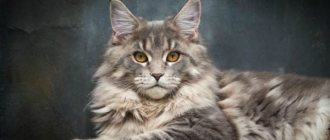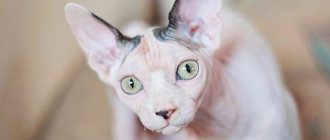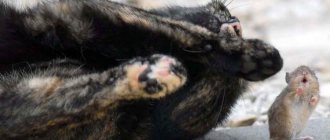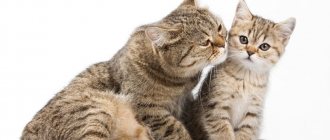For some they are cute and fluffy family members, for others they are an enemy that threatens the balance of nature. The latter began the “genocide” - by 2020, Australian authorities plan to kill two million wild cats. What forced politicians and environmentalists to take a radical decision and how they are trying to fight them - in the material of Lenta.ru.
Recent news that Australians are cruelly and mercilessly fighting cats has shocked the world community. But despite the cries of human rights activists, the country's government has clearly outlined its goal of exterminating two million wild cats by 2020, representing a significant portion of the continent's entire cat population, which is estimated to range from two to six million individuals.
In some areas of Australia, the fight against cats has taken on frankly sadistic features. So, in the north-eastern state of Queensland, authorities are issuing a reward of ten dollars for the scalp of a wild cat.
But it should be noted that it is not only the green continent that is distinguished by its hatred of cats. In neighboring New Zealand, renowned environmentalist Gareth Morgan has proposed a vision for a cat-free future. In his new ideal world, the population of domestic and wild cats is either tightly controlled or destroyed altogether.
Australians themselves have nothing against cute pets. But wild cats, whether born in the wild or simply abandoned by their owners, pose a great threat to other animals. Experts estimate that feral cats kill 75 million wild animals every night across Australia, including birds, frogs, small mammals and reptiles. The statistics are impressive: every year, 316 million birds and 596 million reptiles become victims of cats.
Because of feral cats, it is also impossible to restore endangered species. When people artificially populate certain areas with animals, cats begin to hunt rare animals and kill them. They caused the extinction of several species of marsupials, as well as a unique species of bird - the paradise parrot.
It is believed that the first cat arrived in Australia in the 17th century along with the Dutch. Cats began to reproduce rapidly, and by the mid-19th century large packs of feral cats appeared in the wild. At first, people benefited from such a neighborhood: cats protected farms from rats and mice. Now that they have already inhabited the entire country, except for the tropical forests and some coastal islands, this has become a problem.
Wildcat in Western New South Wales, Australia
Photo: Universal Images Group / Auscape / Diomedia
1/2
Of course, Australian wild cat colonies did not appear on their own. The growth of their population is primarily the responsibility of people who abandon their pet unsterilized cats or allow them to roam the streets unattended.
According to research, 13 percent of Australian cats have produced offspring before being spayed. Unfortunately, not all kittens can be placed in homes with loving owners. Some end up in overcrowded shelters, where they are euthanized after a while, while others join feral cat colonies.
In Australia, cats are divided into three groups: domestic, stray and feral - individuals that survive without any help from humans. They are the main target of the government for reduction or complete destruction.
Feral cats certainly have a detrimental effect on the small animals around them. But do not assume that domestic cats that walk on their own do not pose a threat to birds and small lizards. They have highly developed hunting instincts, regardless of how well they are fed at home. Their owners, of course, deny this and cannot name the exact number of animals that their furry household members kill. Research shows that people see only 23 percent of the total number of victims killed by cats' teeth and claws.
Feral cats are ordinary domestic cats that are forced to live outdoors and hunt for survival. Since cats arrived in Australia with European settlers, they have wiped out about 20 species of mammals, according to National Threatened Species Commissioner Gregory Andrews. He argues that this fact makes cats the biggest threat to a species unique to Australia.
Related materials
00:06 — February 23, 2018
It's good to be a pussy
Cats were considered human eaters, and now millions are spent on them.
The country, which has been cut off from the rest of the world for thousands of years, is home to the rarest species of mammals, birds and reptiles. Experts estimate that 80 percent of Australia's mammals and 45 percent of its birds are found nowhere else on the planet. For cats, these animals are easy prey.
“We're not doing this because we hate cats,” explains Gregory Andrews. “We must make a choice to save the animals we love and who define us as a nation.”
In 2020, the Australian government announced that it intended to eradicate more than two million feral cats by 2020 through shooting, trapping or poisoning, and pledged five million Australian dollars to support community groups that would be directly involved in the hunt.
Despite the fact that this decision was made to preserve the natural balance, the government's plan was criticized by environmentalists. Tim Doherty, an ecologist at Deakin University in Australia, agrees that feral cats cause irreparable damage to animals unique to Australia, but believes the decision to kill so many is based on inaccurate data.
“At the time the target was set, in 2020, we actually didn’t know exactly how many feral cats there were in Australia,” said Tim Doherty, adding that some estimates put the number at 18 million at the time, which is “a rough estimate.” revaluation." Another problem is that simply killing a cat will not necessarily save the lives of birds and mammals. The cat must live in an area where there is a real threat to the survival of the particular species. Incentives for killing cats should also be focused on areas in need.
Because cats are such a big problem for Australia's ecosystem, the ecologist says the government is focusing on them at the expense of more sensitive policy issues such as habitat loss caused by urban expansion, logging and mining.
“There is a possibility that cat hunting is to some extent a distraction,” the scientist says. “We need a more holistic approach and addressing all threats to biodiversity.”
Wildlife Conservancy Australia employee
Photo: australianwildlife.org
1/2
The famous British singer Morrissey called the actions of the Australian government “idiocy.” “We all know that idiots rule the Earth, but idiocy goes too far,” Morrissey said in 2020. “Cats that keep the rodent population under control will be killed in a savage manner, using compounds that are excruciating poisons that cause unimaginable, long-lasting and terrible suffering. The people of Australia would never agree to this, but of course they were not consulted because the Australian government, run by Tony Abbott, is essentially a committee of sheep farmers who have no regard for animal welfare or respect for them."
The famous French actress Brigitte Bardot wrote an open letter to the Federal Minister for the Environment of Australia, filled with angry words: “This genocide of animals is inhumane and ridiculous. In addition to being cruel, killing these cats is completely futile as the rest will continue to reproduce. Your country is stained with the blood of millions of innocent animals, so please do not add cats to this painful list."
If you have a wild kitten, how to tame it?
Feral kittens are initially afraid of people and tend to hide in a dark corner. Don't interfere with this. The pet may crawl into a box, under the bathroom, under a closet, or into the kitchen counter. Try not to touch him or disturb him again. When the baby gets used to it a little and calms down, start taming it.
Place a bowl of food near the place where the animal has settled. To start, use soft cat food or a small amount of fresh meat. Sooner or later, aromatic food will attract a hungry animal, and it will come out of its shelter. At this stage, it is important to make a positive impression on the kitten. This way he will understand that the person is bringing food.
Gradually move the bowl towards the center of the room. This way you will force the animal to go further and further. Don't force things, give your pet time to get used to it. Don't force him to eat. He will come out on his own during times of severe famine. Don't know how to tame a wild kitten? Use meat pieces or special food. When the frightened animal leaves its shelter, show it a treat at arm's length. Driven by the desire to eat, he will carefully crawl up and take the food.
You can try to pet the savage. Do not make sudden movements, do not swing at the kitten, carefully extend your hand and lower it onto the back or face of the animal. Don’t rush things; if the animal is afraid, it’s better not to touch it. Speak in a quiet and calm voice at this moment, as loud sounds will frighten the baby.
If you don't know how to train a kitten to be handled, ask experienced people for advice or rely on your intuition. Any phenologist will tell you that affection and a patient approach can correct any animal. Therefore, try to pick up a wild kitten in your arms more often, stroke it and talk to it quietly and affectionately. Over time, he will get used to the warmth of your hands and begin to caress you in return.
Related materials
00:03 — December 22, 2017
Cat for an hour
Who strokes, cuddles and feeds cats for money and why
Morrissey and Brigitte Bardot are veterans of the animal rights movement. The former Smiths frontman, who released an album called Meat is Murder, became a vegetarian at age 11 and has always opposed meat-eating propaganda, organizing protests against McDonald's in Canada and the Jamie Oliver show.
Before the letter to the Australian minister, Brigitte Bardot called on the Thai government to end the dog meat trade and criticized Poland for its cruelty to geese.
Representatives of the organization PETA Australia (People for the Ethical Treatment of Animals) are confident that the path chosen by the country's government in the fight against the increase in the population of wild cats is too cruel and inhumane. They remind you that wild cats avoid people, which makes them almost impossible to hit from a distance with a weapon. Hunting cats results in non-fatal wounds, which subsequently become infected and lead to a slow, painful death. Poisonous baits are also not a universal remedy: cats who prefer to hunt avoid them, but the same birds or lizards can easily get poisoned and die.
Animal rights activists say the best way to control the feral cat population is to consistently capture individuals and euthanize them afterwards. In their opinion, this is the only way to relatively humanely remove these animals from the environment. As a preventive measure, animal activists are demanding that state governments pass laws that would require pet cat owners to sterilize their pets and keep them exclusively in their own homes. Mandatory cat sterilization laws have already been passed in South and Western Australia, and in the Canberra and Melbourne areas, domestic cats are prohibited from roaming the streets.
Another humane and long-term effective method of reducing feral cat populations is the use of cat birth control, which has a long-term effect on reducing female fertility.
Intraspecific aggression:
- Fights between cats, especially during mating season
- Competitive aggression if several animals live in the same house
- Sexual aggression: cats bite cats on the neck forcefully during mating, and cats viciously attack cats after mating
- Male aggression: when cats kill and even eat other people's offspring
- Territorial aggression: cats defend their territory, which includes sleeping and feeding areas.
- Maternal aggression is the selflessness of a mother protecting her offspring.
Why did the cat become aggressive?
Why did the cat become aggressive?
Sudden aggression in cats is a fairly common problem in families with such a pet. You can often hear stories about how an angry cat shows aggression quite suddenly, although it has been gentle and docile for many years. In this case, the animal rushes at the owners and guests, hisses and does not go into their arms. There are quite a few reasons for this behavior of tailed animals.
By their nature, cats are non-aggressive animals; on the contrary, they are very kind to people, especially if they reciprocate their sympathy. If the pet grew up in a good atmosphere with caring and kind owners, and regularly received a portion of affection and tenderness, then aggression in the cat is not observed. It happens, of course, that such a trait is part of the breed's characteristics; in this case, the cat is always angry, and its behavior is practically impossible to correct.
For example, white cats are considered more aggressive than others. Most likely, this is due to the predominance of Angora blood in them. Their hostility can also be explained by the fact that many representatives of the Turkish Angora are deaf, and therefore always feel insecure. These animals do not hear danger from behind, so they must be on guard all their lives. Blue cats take second place in terms of aggression, it is unknown what this is connected with for them!
As a rule, aggression in cats manifests itself quite suddenly. Most stories about such incidents begin approximately the same way - an angry cat attacks its owner without a voice warning, and bites and scratches him so hard and painfully that it seems to want to kill him. After the attack, the animal is in an excited and even nervous state, its pupils are dilated, its heart rate is rapid, its tail is shaking, and after some time the attack is repeated again.
Moreover, the rest of the time the animal does not behave this way and the cat’s aggressiveness has no reason. Such outbursts of rage can be explained in different ways, but basically, all the reasons can be divided into three groups: pain, fear and struggle for territory.
Pain
If your cat's aggression has no apparent reason, the first thing to do is take him to see a veterinarian. Even if you do not observe any symptoms, and your pet’s sleep and appetite are fine, this does not mean that he is healthy. Many diseases occur hidden, but at the same time greatly disturb the animal.
For example, a cat becomes angry due to organic diseases such as ischemic encephalopathy, toxoplasmosis, heavy metal poisoning, hepatoencephalopathy, hyperthyroidism or epilepsy. Or perhaps your pet simply has a hormonal imbalance, and simple castration or sterilization will correct the matter!
Another important health-related item is nutrition. Pay attention to when your cat is aggressive. If after eating, then perhaps this is due to low-quality products. Unfortunately, not all food meets veterinary and sanitary standards, and unscrupulous manufacturers may use low-quality raw materials, including hallucinogenic substances, as ingredients. Such products can provoke visions, which may be what causes the cat’s aggression. Pay attention to how your pet behaves after eating. If, after eating, she does not stretch contentedly, does not lick herself satisfactorily and does not go to the side, but, on the contrary, waves her tail, looks around anxiously and shudders, then, most likely, it is as a result of eating such foods that the cat has become aggressive.
Older animals, like people, suffer from age-related changes and related diseases, which can also be a cause of anger. When your pet, for example, has aching paws, and you suddenly pull him towards you and want to caress him, then the only way to explain to you that he wants peace is to hiss and scratch him. Such outbursts of aggression, of course, will not spoil a good relationship, but you must understand that your pet is no longer that flexible kitten who is always ready to play, run and hug, and therefore you need to treat him very carefully, do not grab him or insist on communication .
Fight for territory
The territory of a cat is a topic as old as time! The common belief that cats are very independent creatures does not mean that they do not need communication and are generally loners by nature. No, for them independence is their territory, which cats protect very jealously.
Aggression in a cat can also be caused by defending its hierarchical rank. For such animals this concept is closely related to the concept of territory, since in both cases we are talking about competition with another creature. And often it is by defending the territory that the cat becomes taller than the opponent. These are such animals!
Moreover, the cat’s aggression, initially directed at his opponent, can spread to you. The head of the cattery, Galina Ivanova, recommends using a special system of step-by-step actions to introduce a new cat into the house, which requires time and patience, but gives excellent results.
Fear
If the aggressiveness of cats is a consequence of psychological problems, then adjusting behavior in this case is quite difficult. As a rule, the reason for such problems is fear, rooted in childhood. If a cat is not evil by nature, then, most likely, events have occurred in her life that now do not allow her to treat humans or other animals with complete trust.
For example, stray cats or animals that lived in shelters or simply inappropriate conditions have a more difficult time getting used to people. If you take such a pet, you must understand that he may never be able to trust you completely, and it will take more than one day to establish a good relationship with such an animal. Moreover, the aggressiveness of cats will most likely not go away forever.
Social behavior is formed in animals in early childhood. If the baby was caressed and stroked at least 10 minutes a day during the first two weeks of life, then he will be affectionate and will be able to trust people. If the animal was not picked up or touched at all, then the cat’s aggression will definitely manifest itself sooner or later. In addition, he will always be distrustful of a person.
No less important for the formation of adequate behavior is communication with relatives. If a kitten is isolated from its siblings, it will not go through the necessary phase of learning to control relational aggression and understand what such actions can lead to. As a result, he may develop an abnormal reaction to animals. In addition, it is very important what kind of diet his mother had during pregnancy and lactation. If the cub did not receive the necessary substances, then it will lag behind in development and learn poorly.
If your new pet was bought from good people, and you have no doubt that its first months of life were spent in a good atmosphere, then, most likely, aggression in a baby cat can be explained by simple hooliganism. If your cat is too active, expert Galina Ivanova recommends playing with him more, using teasers, various mice and balls. Let the cat's energy be released onto these objects and not into your hands. Otherwise, the cat’s aggression will become a habitual part of his life.
It is important from the first days of the kitten’s stay in the house to let him understand that you do not allow him to attack, bite and scratch. To do this, you can spray it with water from a spray bottle during such attempts. To make your pet understand that human hands are a source of affection, you can smear them with something aromatic, for example, sausage. Agree that it could be more pleasant for a cat!
If you take in a stray animal, at first it will behave warily, but then the cat will begin to show aggression. Due to the trials that the poor fellow had to endure, he can hardly trust people unconditionally. And if he recognizes someone as the owner, then only in one person; he will most likely treat the rest of the residents of the apartment or house with distrust and indifference.
Often people, succumbing to a noble impulse, adopt a stray animal without weighing the pros and cons. As a result, the evil cat begins to show aggression and even attack children. At the same time, inexperienced owners use the wrong methods of education. For example, if you put such a pet on a leash, the cat’s aggression will only become stronger and intensify. Indeed, in this position the animal has no opportunity to escape from the offender, so he feels like an object of attack.
If you adopt a pet with a difficult life, then under no circumstances should you tie it up, spank it or punish it. Give him time to get comfortable. Give the cat peace, quiet and complete freedom, let him feel that there is nothing scary in the house. Be sure to warn all household members and especially children that you should not impose your communication on the new resident, let the acquaintance and rapprochement happen by themselves. Protect him from excessive attention from guests. Don't forget to appease your pet with treats and toys. And most importantly, you must understand that such an animal will most likely never be able to trust you one hundred percent.
Often an angry cat becomes this way due to loneliness. As we said earlier, such animals are very social and need communication. In addition, they need to waste their energy. The animal must have a lot of toys, and if you have two pets who have lived together since childhood, then rest assured that the cat’s aggressiveness will not threaten you. But if the pet has nowhere to put its energy, then all that remains is to take it out on the owner. In addition, there are breeds that especially need companionship, such as Orientals or Balinese.
It also happens that a cat’s aggression is the result of the fact that the owners simply do not know what the cat needs due to its nature. For example, when an aggressive animal is taken out to the country, and the evil cat suddenly turns out to be very kind. And the whole point is that the pet simply needed space and freedom. In such situations, owners always note a significant decrease in aggressiveness and changes in mood.
Remember, sudden aggression in a cat always has a reason. If your pet suddenly starts attacking you, do not punish him without finding out what is wrong. Perhaps the day before your pet was barked at by a neighbor’s dog, or your child offended the cat, or maybe the animal is simply sick. In any case, an angry cat needs care and attention, but not punishment.
Your cat's huge eyes indicate her predatory tendencies.
Of all the cats, only the cheetah specializes in hunting during the day, and therefore has rather small eyes. Many large cats have slightly larger eyes and are more sensitive than ours, allowing them to hunt by moonlight as well as during the day. But most small species, including the domestic cat, are primarily nocturnal in the wild. In order for them to gather enough light to see, their eyes are huge relative to their skulls—the eyes of a domestic cat are almost as large as a human's.
Inside the eye, the retina is about six times more sensitive than ours and is connected to the brain in a way that maximizes sensitivity at the expense of sharpness. All cats also have a reflective layer behind the retina, the tapetum, which further increases sensitivity and at the same time creates a peculiar green “eye shine” when exposed to a beam of light.











